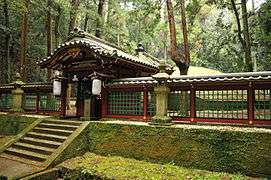Kakuban
Kakuban (覚鑁/覺鑁; 1095–1143), known posthumously as Kōgyō-Daishi (興教大師) was a priest of the Shingon sect of Buddhism in Japan and credited as a reformer, though his efforts also led to a schism between Kogi Shingon-shū (古儀真言宗, Old Shingon) and Shingi Shingon-shū (新義真言宗, New Shingon). Kakuban is also famous for his introduction of the "esoteric nembutsu".


Biography
Kakuban was born in Fujitsu-no-shō (Hizen Province, nowadays part of Kashima City, Saga Prefecture) about three hundred years after Shingon Buddhism was first founded by Kūkai (空海). His given name was Yachitose-maro (弥千歳麿).
The third of four children, his father died at the age of 10, so he renounced the world at age 13 to enter the priesthood and became a pupil of the famous teacher, Kanjo (寛助) in Kyoto, who in turn had founded the Jōju-in (成就院).[1] Kakuban had briefly studied the Kusha and Hossō teachings at Kōfuku-ji in Nara before returning to his master. At that time, he was given the ordination name of Shōgaku-bō Kakuban (正覚房覚鑁).[2] After prolonged training in Buddhism at Tōdai-ji in Nara, the twenty-year-old received full ordination. Kakuban left for Mount Kōya (Kōya-san), then the center of the Shingon sect, to pursue further learning of Shingon Buddhism and its founder under the tutelage of Shōren (青蓮), a devout follower of the Pure Land teachings.[3]
By age 30, he received patronage from the noble families in Kyoto, including Cloistered Emperor Toba's permission to build the Denbō-in (伝法院) on Mt. Koya as a center for studying Buddhism. The following year, he constructed the Daidenbō-in (大伝法院).
Schism
When he was thirty-six, Kakuban took leadership in the revival of the Shingon Sect, by attempting to unify the existing branches of Ono (小野) and Hirosawa (広沢). Further, he attempted to assert authority of the Shingon sect from Mt. Koya, not the traditional seat at Tō-ji in Kyoto. Eventually, he gathered an increasing throng of followers and became the chief priest (座主, zasu) of both the temples Daidenbō-in and Kongōbu-ji.[4] In time, he came to govern the entire religious district of Kōyasan as the chief priest under Imperial decree. This led to animosity from some monks, who called for his expulsion. Kakuban soon resigned from his post as chief priest (1135), and retired to Mitsugon-in (密厳院).[5]
The animosity continued, however, and armed monks burned down the Denbō-in Temple in 1139. Kakuban and his pupils fled to Negoro-ji, where Kakuban ended his days at the age of 49 on December 12, 1143.[6] According to legend, he died while sitting in the lotus posture, facing an image of Vairocana's Pure Land. His ashes remain buried in a tomb in the Okunoin cemetery there. Later he was given the posthumous title of Kōgyō-daishi (興教大師, Great Master of Prosperous teachings) by Emperor Higashiyama in 1690.
One of his disciples, Raiyu (頼瑜, 1226–1304) moved the Daidenbō-in and the Mitsugon-in Halls to Negoro-ji in 1288 and established the independence of a new school called Shingi Shingon (新義真言宗, New Shingon).
Teachings
Kakuban wrote many works elaborating on the foundational teachings of Kūkai, as well as existing rituals at the time, however he also introduced a new ritual called the himitsu nembutsu (秘密念仏, esoteric nembutsu). Kakuban, in keeping with Shingon thought, felt that the regular nembutsu used in Pure Land Buddhist practices contained esoteric elements as well. In the Amida Hisshaku (阿弥陀秘釈, The Esoteric Meaning of Amida), he describes each of the syllables of the nembutsu, their underlying esoteric meaning, and the important symbolism of breath as life, and as a means of recitation.
Similarly, he analyzed mantras related to Amitabha Buddha in the Shingon tradition, in order to discover their hidden meanings.
References
- Giebel 2004, p. 241.
- Inagaki 2004, p. 102.
- Giebel 2004, p. 242.
- Inagaki 2004, p. 104.
- Giebel 2004, p. 244.
- Giebel 2004, p. 245.
Sources
- Giebel, Rolf W.; Todaro, Dale A.; trans. (2004). Shingon texts, Berkeley, Calif.: Numata Center for Buddhist Translation and Research. ISBN 1886439249
- Inagaki, Hisao, trans. (1994). "The Esoteric Meaning of 'Amida'" by Kakuban, Pacific World 102-115
External links
- (in Japanese) Bibliography
- (in Chinese) Bibliography
- "Biographies of Dharma Masters". Archived from the original on 2009-05-08. Retrieved 2009-02-08.
- "Early Japanese Pure Land Masters". Retrieved 2009-02-08.
- "Kakuban's "Amida Hishaku"". Archived from the original on 2009-04-19. Retrieved 2009-03-03.